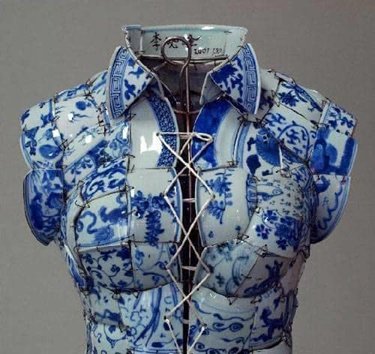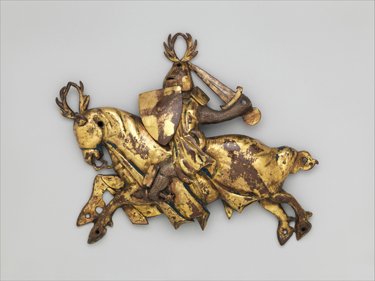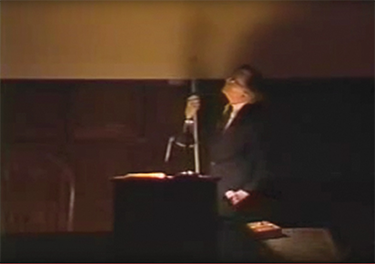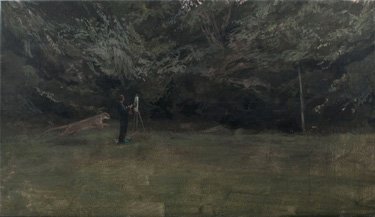Category Archive 'Art'
25 Aug 2020

Jacek Yerka, Bible Dam.
09 Aug 2020


Sold 25 November 2017
CHU TEH-CHUN (ZHU DEQUN, FRANCE/CHINA, 1920-2014)
Poussée Cristalline (Unrevealed Crystal)
Price realised
HKD 22,300,000 ($2,899,000)
Estimate
HKD 10,000,000 – HKD 16,000,000
—————————-
Wikipedia:
Chu Teh-Chun or Zhu Dequn (24 October 1920 – 26 March 2014) was a Chinese-French abstract painter acclaimed for his pioneering style integrating traditional Chinese painting techniques with Western abstract art. …
Chu Teh-Chun was born in 1920 in the town of Baitu in Xiao County, which was then in Jiangsu province but now part of Anhui province. In 1935 he entered the National School of Fine Arts (now China Academy of Art) in Hangzhou, Zhejiang, graduating in 1941. At the school he studied Chinese painting under Pan Tianshou and Western art under Fang Ganmin and Wu Dayu, who were prominent Chinese artists trained in France. …
In 1945 Chu became a faculty member of the architecture department of the National Central University in Nanjing, then China’s capital. With the communist victory in mainland China, Chu moved to Taiwan in 1949, joining the National Taiwan Normal University where he taught Western-style painting. He moved to Paris in 1955, where he lived for the rest of his life. He became a French citizen in 1980, and a member of the Académie des Beaux-Arts in 1997. …
Inspired by Nicolas de Staël’s abstract landscape paintings, Chu abandoned figurative painting and adopted a unique style using bold strokes of colour which evoked Chinese calligraphy. His new style was immediately successful. In 1964, an exhibition of his works at the Carnegie Museum of Art in Pittsburgh brought him international fame. On 17 December 1997, Chu was elected a member of the Académie des Beaux-Arts of France, the first Frenchman of Chinese origin to be chosen. He was also made a Chevalier de l’Ordre des Palmes Académiques and Chevalier de la Légion d’Honneur in 2001. His paintings are now in the permanent collections of more than 50 museums all over the world. Major exhibitions of his work were held at the Shanghai Art Museum in 2005 and Beijing’s National Art Museum of China in 2010.
08 Aug 2020


My Modern Met:
Chinese contemporary artist Li Xiaofang uses porcelain to make wearable art that pays homage to China’s past while looking toward the future. Xiaofang takes hundreds of shards of porcelain, some dating back to the Song, Ming, and Qing dynasties, and puzzles them together into magnificent porcelain dresses. His wearable art acts as both a coat of armor and a sculptural masterpiece.
Xiaofang sews together the shards using thin metal wire, and each is lined with a leather undergarment. Looking at the artist’s work, it’s impossible not to marvel at the precision and care taken, not only to find the exact shapes to form the curves of the dresses, but also how the pattern and color of the porcelain are used to create new shades and silhouettes. But Xiaofang doesn’t only limit himself to porcelain dresses, he’s also experimented with creating suit jackets, pants, blouses, and even a military hat.
The Beijing-based artist has seen his work exhibited at the Metropolitan Museum of Art and has engaged in collaborations with fashion giants like Lacoste and Alexander McQueen. A visionary in his field, his work was by the rapid development engulfing Beijing. “These blue shards, bathed in the sunny skies of socialism and caressed by the contemporary cool breezes blowing from the west throughout the capital, assume a bewildering array of postures as fashion items entering the new century,†the artist once stated. “These are the blue-and-white costumes! These emanate the splendor once crushed! These are the illusions flowing with sorrow!â€
RTWT
29 Jun 2020

Lot 132: DAUM Important tubular vase with conical neck on pedestal.
Est: €18,000 – €20,000
€18,000 0 bids
OGER – BLANCHET
July 2, 2020, 2:30 PM CET
Paris, France
DAUM
Important tubular vase with conical neck on ringed pedestal. Made in purple and white marbled glass. Decorated with violets etched with acid and entirely enhanced with natural polychrome enamel. Lower part and pedestal decorated with engraved leaves and insects enhanced with gilding.
Signed in gold under the base.
High. : 70 cm
Similar to model presented by Daum Establishments at the Nancy International Exhibition in 1909.
———————
I get lots of auction notices by email.
I’d buy this one for my wife like a shot, except not for €18,000, alas!
27 Apr 2020

Ornamental Plaque of a Knight, ca. 1300, possibly British, Metropolitan Museum of Art.
My guess would be German, because of the antler crests.
18 Feb 2020


The late Vincent Scully lecturing Eurocentrically years ago.
Heather MacDonald, BK ’70, demolishes the cant being used to justify remodeling Yale’s once-illustrious History of Art Department into a distribution center for Marxist agitprop and Multicultural Identity Stroking.
By 1974, when I enrolled at Yale, its faculty had long since abdicated one of its primary intellectual responsibilities. It observed a chaste silence about what undergraduates needed to study in order to have any hope of becoming even minimally educated; curricular selections, outside of a few broad distribution requirements, were left to students, who by definition did not know enough to choose wisely, except by accident. So it was that I graduated without having taken a single history course (outside of one distribution-fulfilling intellectual history class), despite easy access to arguably the strongest American history faculty in the country. Scully’s fall semester introductory art history course has been my anchor to the past, providing visual grounding in the development of Western civilization, around which it is possible to develop a broader sense of history.
But now, the art history department is junking the entire two-semester sequence, as the Yale Daily News reported last month. Given the role that these two courses have played in exposing Yale undergraduates to the joys of scholarship and knowledge, one would think that the department would have amassed overwhelmingly compelling grounds for eliminating them. To the contrary, the reasons given are either laughably weak or at odds with the facts. The first reason is the most absurd: the course titles (“Introduction to the History of Art: Prehistory to the Renaissance†and “Introduction to the History of Art: Renaissance to the Presentâ€). Art history chair Tim Barringer apparently thinks students will be fooled by those titles into thinking that other traditions don’t exist. “I don’t mistake a history of European painting for the history of all art in all places,†he primly told the Daily News. No one else would, either. But if the titles are such a trap for the Eurocentric unwary, the department could have simply added the word “European†before “Art†and been done with it. (Barringer, whose specialities include post-colonial and gender studies as well as Victorian visual culture, has been teaching the doomed second semester course—a classic example of the fox guarding the henhouse.)
Barringer also claims that it was “problematic†to put European art on a pedestal when so many other regions and traditions were “equally deserving of study.†The courses that will replace the surveys will not claim to “be the mainstream with everything else pushed to the margins,†he told the Daily News. Leave aside for the moment whether the European tradition may legitimately form the core of an art history education in an American university. The premise of Barringer’s statement—that previously European art was put on a pedestal and everything else was pushed to the margins—is blatantly false. The department requires art history majors to take two introductory-level one-semester survey courses. Since at least 2012, the department has offered courses in non-Western art that can fulfill that requirement in lieu of the European surveys. Those classes include “Introduction to the History of Art: Buddhist Art and Architectureâ€; “Introduction to the History of Art: Sacred Art and Architectureâ€; “Global Decorative Artsâ€; “The Politics of Representationâ€; and “The Classical Buddhist World.†No one was forced into the two Western art courses.
Nor would anyone surveying the art history catalogue think that Yale was “privileging†the West, as they say in theoryspeak. That catalogue is awash in non-European courses. In addition to the introductory classes mentioned above, the department offers “Japan’s Classics in Text and Imageâ€; “Introduction to Islamic Architectureâ€; “The Migrant Imageâ€; “Sacred Space in South Asiaâ€; “Visual Storytelling in South Asiaâ€; “Aztec Art & Architectureâ€; “Black Atlantic Photographyâ€; “Black British Art and Cultureâ€; “Art and Architecture of Mesoamericaâ€; “The Mexican Cultural Renaissance, 1920– 1940â€; “Painting and Poetry in Islamic Artâ€; “Aesthetics and Meaning in African Arts and Culturesâ€; “Korean Art and Cultureâ€; “African American Art, 1963 to the Presentâ€; “Art and Architecture of Japanâ€; “Textiles of Asia, 800–1800 C.E.â€; and “Art and Politics in the Modern Middle East,†among other courses. The Western tradition is just one among many. Nevertheless, Marissa Bass, the director of undergraduate studies in the department, echoed Barringer’s accusation of Eurocentrism. The changes recognize “an essential truth: that there has never been just one story of the history of art,†Bass told the Daily News. But Yale does not tell just one story of the history of art. Department leaders have created a parody of their own department simply in order to kill off the Western survey courses.
Those courses must also be sacked because it is impossible to cover the “entire field—and its varied cultural backgrounds—in one course,†as the Daily News put it. If this statement means that the span of time covered in each of the one-semester Western art classes is too large, non-Western survey courses are as broad or broader. “Chinese Painting and Culture†covers 16 centuries. “Power, Gender, and Ritual in African Art†covers nearly two millennia. “Introduction to the History of Art: Buddhist Art and Architecture†covers seven centuries. “Introduction to the History of Art: Sacred Art and Architecture†covers several millennia. None of these courses is facing extinction.
Barringer promises that the replacement surveys will subject European art to a variety of deconstructive readings designed to pull that tradition down from its alleged pedestal. The new classes will consider Western art in relation to “questions of gender, class, and ‘race,’†he told the Daily News in an email, carefully putting scare quotes around “race†to signal his adherence to the creed that race is a social construct. The new courses will discuss the involvement of Western art with capitalism. Most intriguingly, the relationship between Western art and climate change will be a “key theme,†he wrote.
Barringer’s proposed deconstruction of Western art illustrates a central feature of modern academia: The hermeneutics of suspicion (Paul Ricoeur’s term for the demystifying impulse that took over the humanities in the late 20 century) applies only to the Western canon. Western academics continue to interpret non-Western traditions with sympathy and respect; those interpreters seek to faithfully convey the intentions of non-Western creators and to help students understand what makes non-Western works great. So, while the replacement European art survey courses will, in Marissa Bass’s words, “challenge, rethink, and rewrite†art historical narratives, the department will not be cancelling its Buddhist art and architecture class due to the low representation of female artists and architects, nor will it “interrogate†(as High Theory puts it) African arts and cultures for their relationship to genocidal tribal warfare, or Aztec art and architecture for their relationship to murderous misogyny.
A must-read.
29 Jan 2020


Thomas Cole, The Course of Empire: Destruction, 1833-1836, New York Historical Society.
James Panero tells us that Yale imported a Cambridge bolshie to “decolonize” the History of Art Department.
Are we in our own revolutionary moment? Many of our leading institutions clearly believe so. Yale University has been working overtime to prove it is on the right side of history. ‘Problematic’ colleges have been renamed. ‘Offensive’ stained-glass windows have been knocked out. Only the leadership of an Ivy League school could spread such a poisonous rash. Heading the charge against the Dead White Male has been a progressive Yale bureaucracy that is, for the most part, pale and stale.
Now the task of dismantling Yale’s famous art history survey course has fallen to a scholar I respect, Tim Barringer. British-born, Barringer is the Paul Mellon Professor of the History of Art at Yale University and has been a leading curator at the Metropolitan Museum. He even mounted the Met’s exceptional 2018 exhibition on Thomas Cole.
Following a 2017 mandate to ‘decolonize’ Yale’s Department of English, Barringer is giving over the keys of Yale’s famous art survey course to the identity vandals. According to the Yale Daily News, instead of one class that will tell the story of art from ‘Renaissance to the Present’, new courses will, Barringer says, be devised to consider art in relation to a five-step history lesson, ‘questions of gender, class and race’, with further discussion of art’s ‘involvement with Western capitalism’. Of course, ‘climate change’ will also be a ‘key theme’.
Art doesn’t fare well in revolutionary times. Likewise, revolutionary sentiments are often revealed in the treatment of art. If only Professor Barringer had looked more carefully at another five-step history lesson, Thomas Cole’s ‘Course of Empire’ tableau (1833-36), he might have seen how civilizations burn down from decadence as well as assault.
RTWT
That whirring sound you hear in the background is grand old Yale Art History professors, men like Sumner Crosby who taught the Gothic Cathedral course and Charles Seymour who taught the Italian Renaissance Art course, who fished for salmon together every summer on the Upsalquitch, spinning in their graves at 78 RPM.
05 Nov 2019


Art News:
As art history lovers flock to the Louvre in Paris to see the blockbuster show celebrating the 500th anniversary of the death of Leonardo da Vinci, a new painting by his hand may have been discovered at a French chateau.
The work, a portrait of a bald man that has been in the historic house for centuries, could be by the Renaissance master, although the evidence is far from clear.
A 145-year-old letter mentioning a portrait of the philosopher Niccolò Machiavelli by Leonardo was discovered last year in the archives of Château de Valençay in central France. The chateau once belonged to Charles Maurice de Talleyrand-Périgord, the French diplomat known better as Talleyrand, who died in 1838 after serving under several French regimes, including Napoleon’s.
The director of the historic house, Sylvie Giroux, told Agence France Presse that “it is not impossible†that Leonardo painted the Italian political theorist, best known for his political treatise, The Prince.
The local archivist, Anne Gerardot, is more cautious. “Just because it says so in the archives does not mean it’s true,†she told AFP, noting that she thinks the Old Master portrait more closely resembles the French Renaissance essayist Montaigne.
There’s also the issue of the painting’s wooden support, which has a smooth appearance uncharacteristic of Leonardo’s time. It could be the result of restoration work done in the 1890s, or a clue that the painting was made at a later date.
But the painting, featuring a thin, bearded figure in a black coat and white shirt with necktie, does match the description in the letter, which mentions a portrait on wood measuring 22 by 17 inches. In the letter, which is dated 1874, the estate manager who wrote it says: “I am having the concierge wrap up and put on the train a box containing a painting (Machiavelli by Leonardo da Vinci).â€
The chateau plans to submit the painting to a battery of tests in the hopes of determining its subject and authorship.
It’s difficult to judge from the photograph, but my own guess is: neither of the above.
08 Aug 2019

Pere Llobera (Spanish, b. 1970), The puma attacking the plein-air artist, 2012.
20 Jun 2019


Art News:
The rusty gun which Van Gogh probably used to shoot himself sold for €162,500 at a Drouot auction in Paris this afternoon. ArtAuction Rémy le Fur, which estimated the revolver at €40,000-€60,000, describes it as “the most famous weapon in art historyâ€. The private buyer has not been named.
Although the seller has also not been identified by the auctioneer, she is believed to be Régine Tagliana, an artist and the daughter of Roger and Micheline Tagliana, who in 1952 had bought the café where Van Gogh lodged in 1890. The Tagliana family were given the gun in around 1960 by the farmer who had found it on his land, just behind the château in Auvers-sur-Oise. This is the village just north of Paris where the artist spent his final 70 days.
The auctioned Lefaucheux pinfire revolver is almost certainly the weapon used, although this cannot be conclusively proved. The type of weapon, its calibre, its severely corroded state and the location and circumstances of the find strongly suggest it is the gun. In the evening of 27 July 1890 Van Gogh suffered a gunshot wound while in a wheatfield and he then staggered back to the inn, dying two days later.
The discovery of the gun once again raises the question of whether Van Gogh committed suicide or was murdered. The 2011 biography by Steven Naifeh and Gregory White Smith argued that he was killed by a local young man, René Secrétan, possibly by accident.
RTWT
Earlier post.
/div>

Feeds
|















